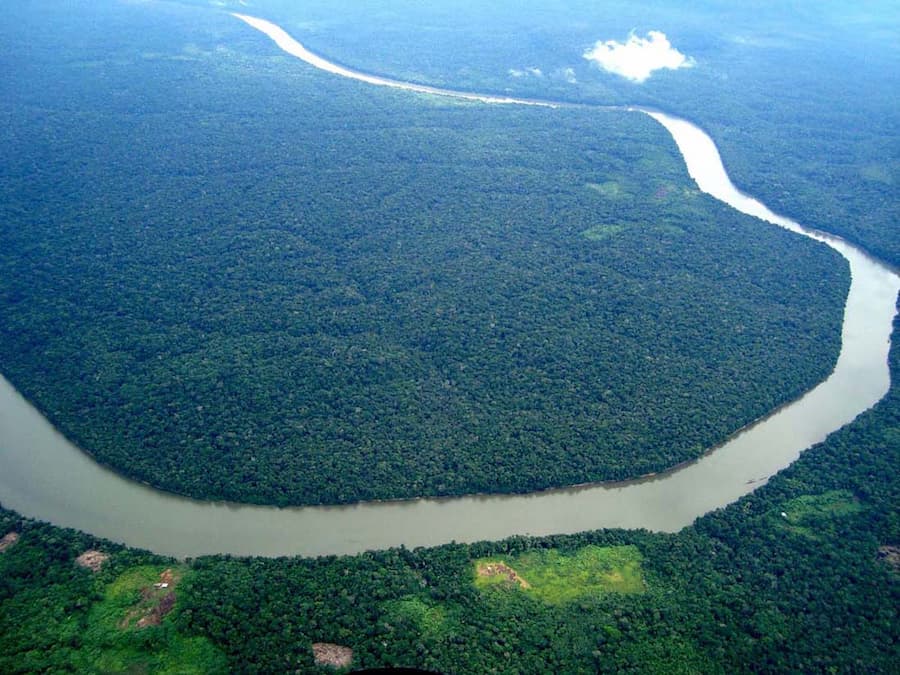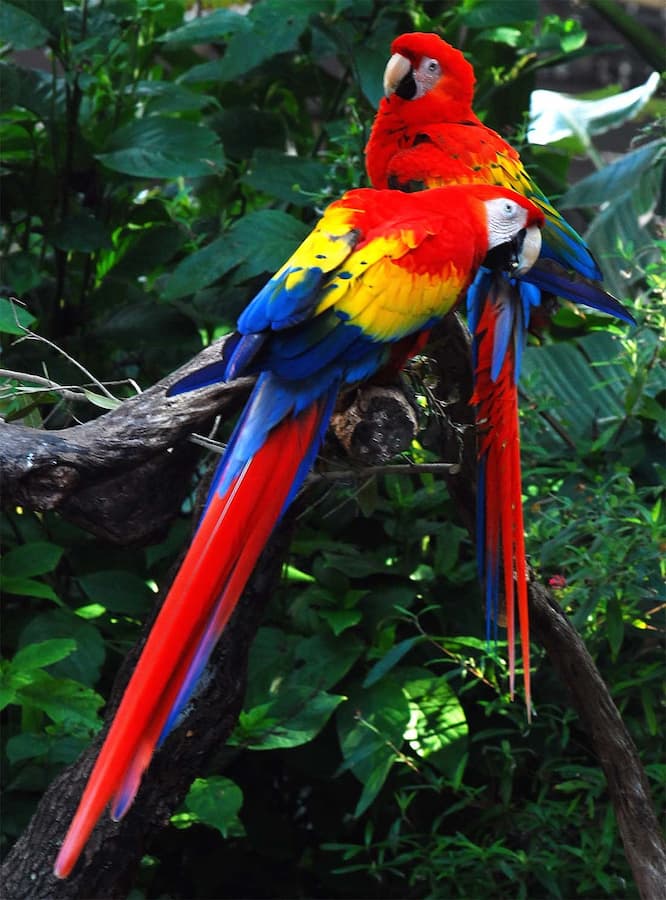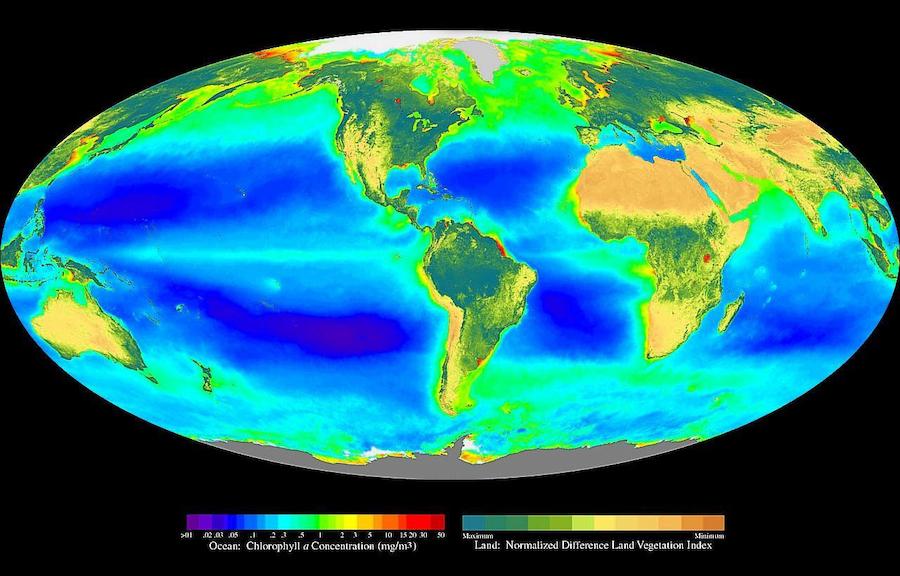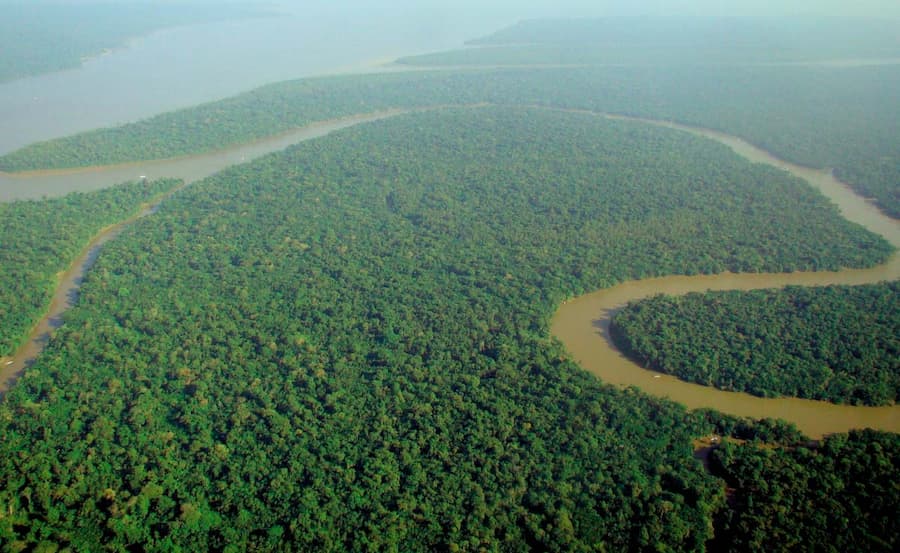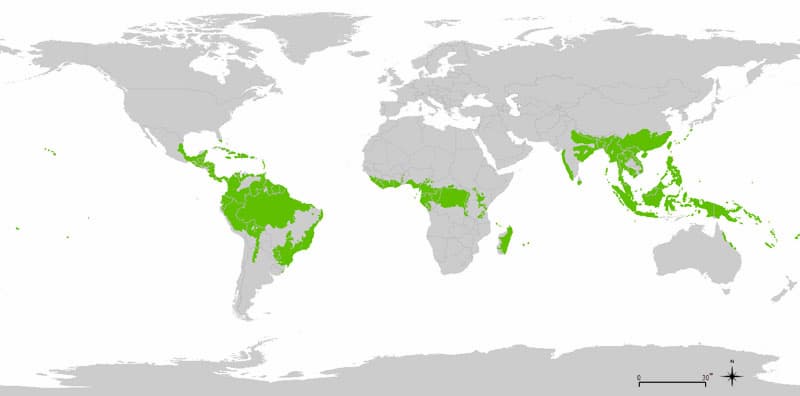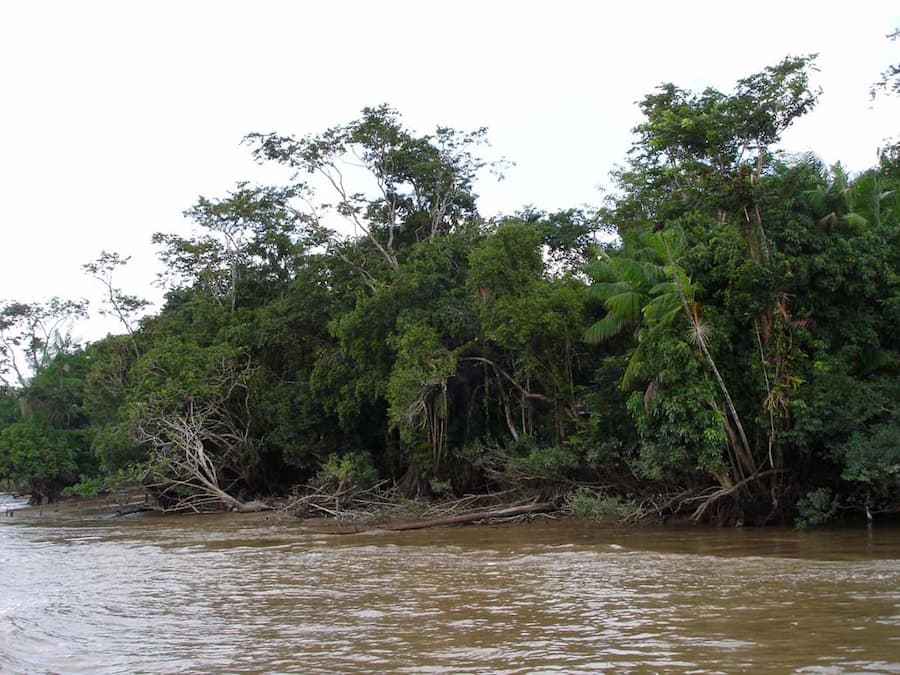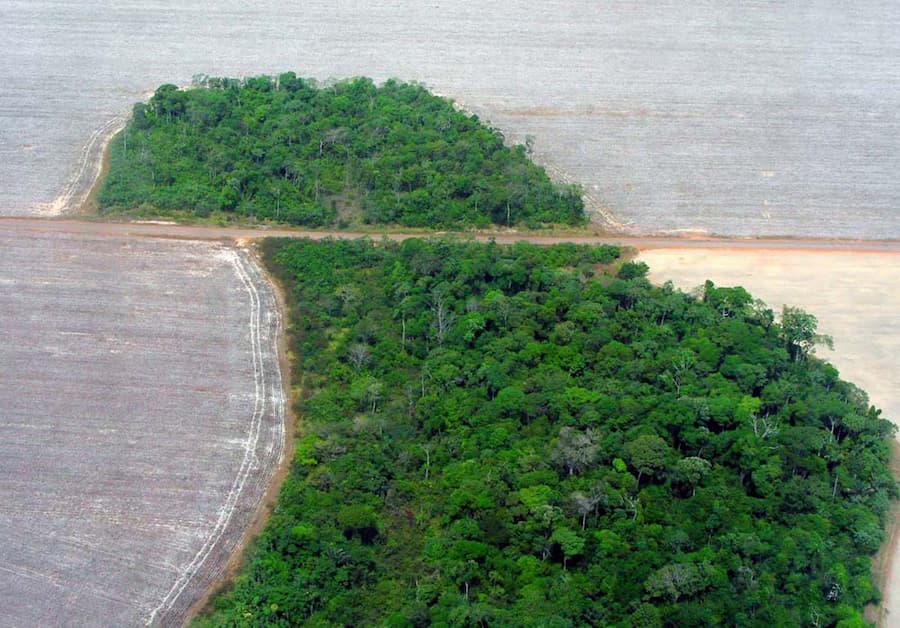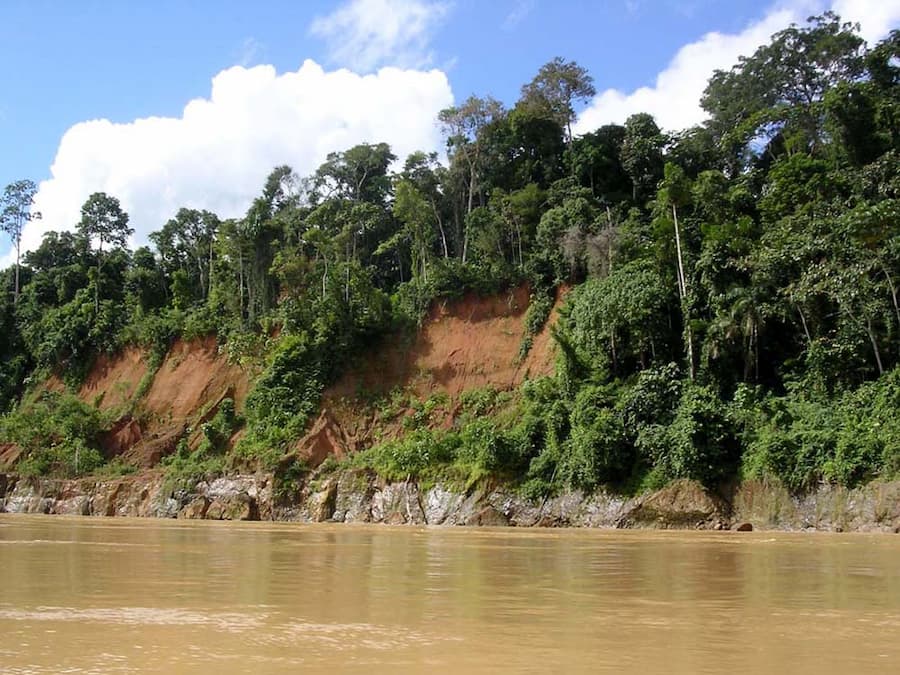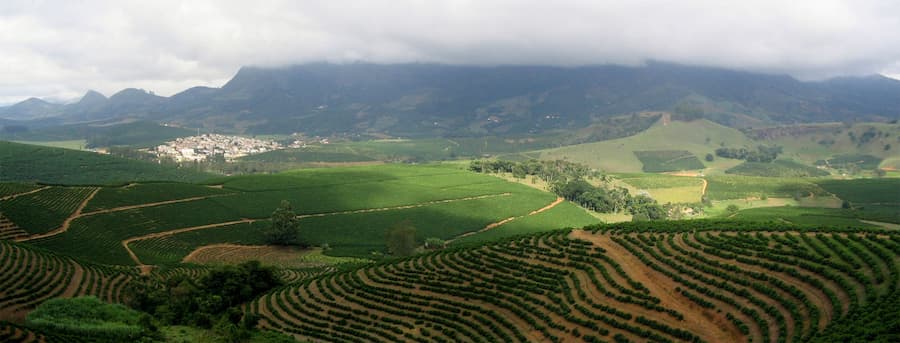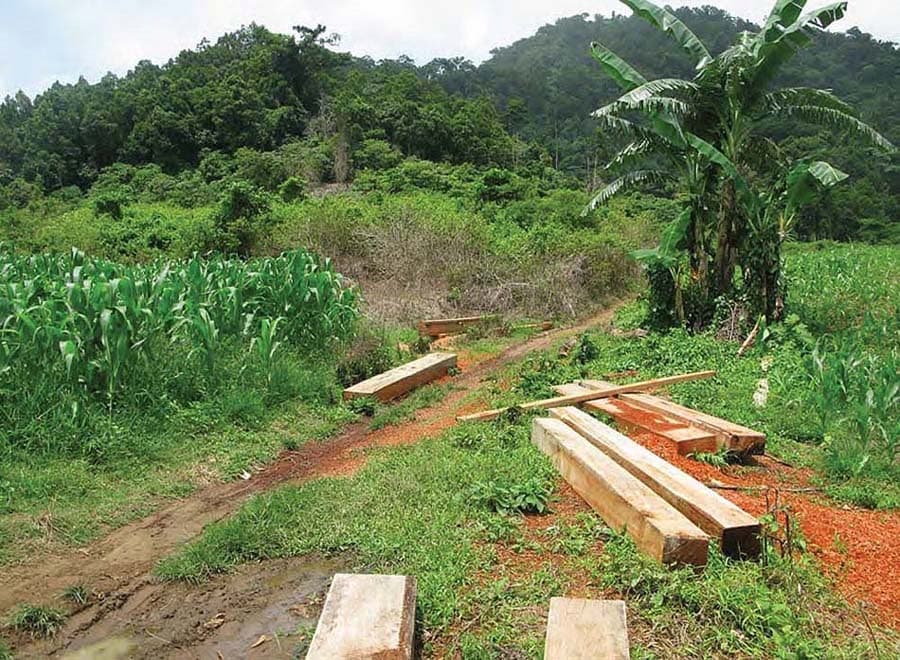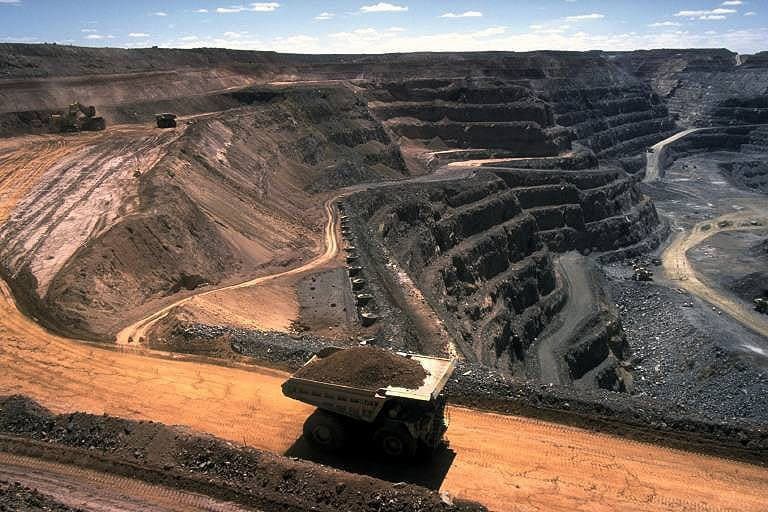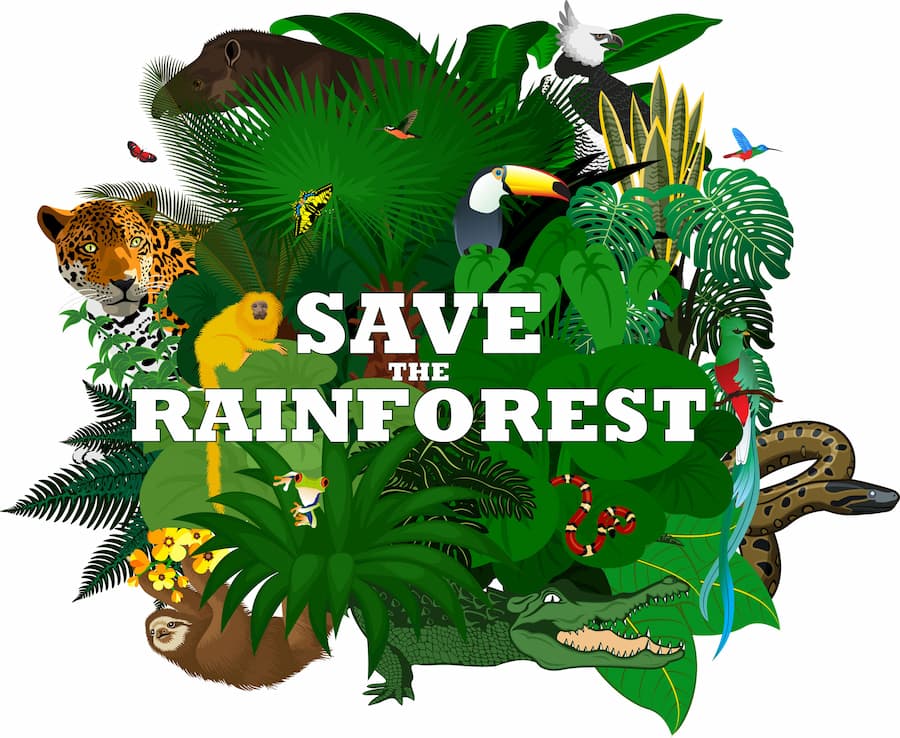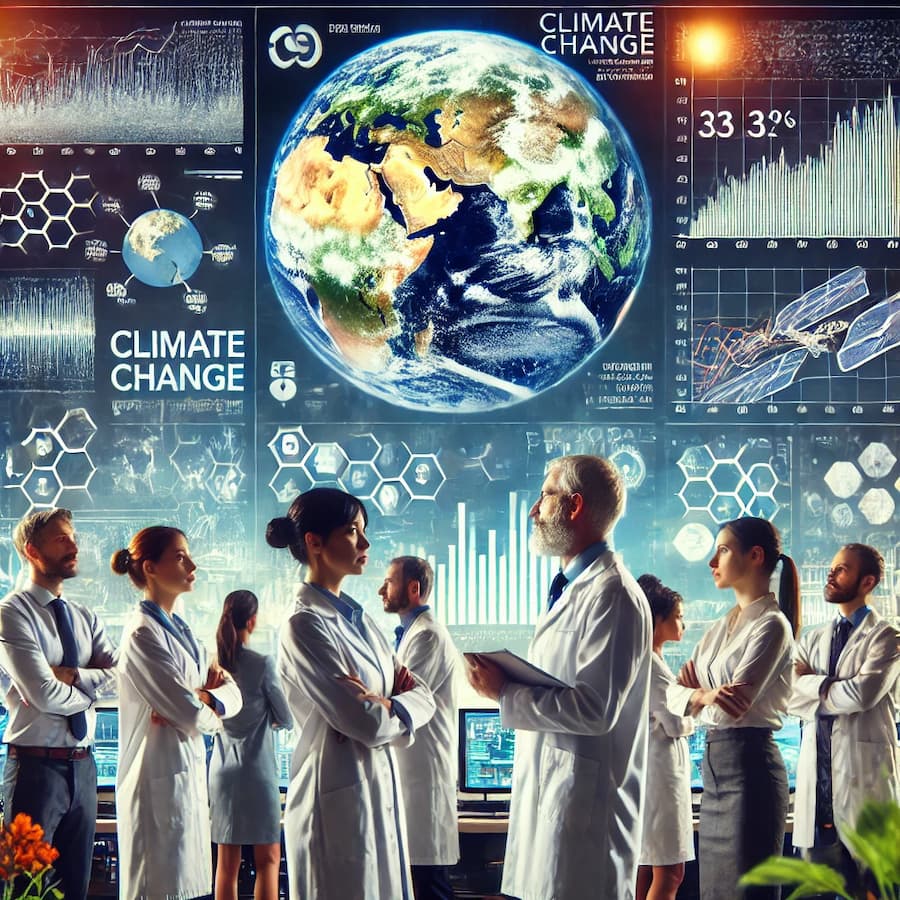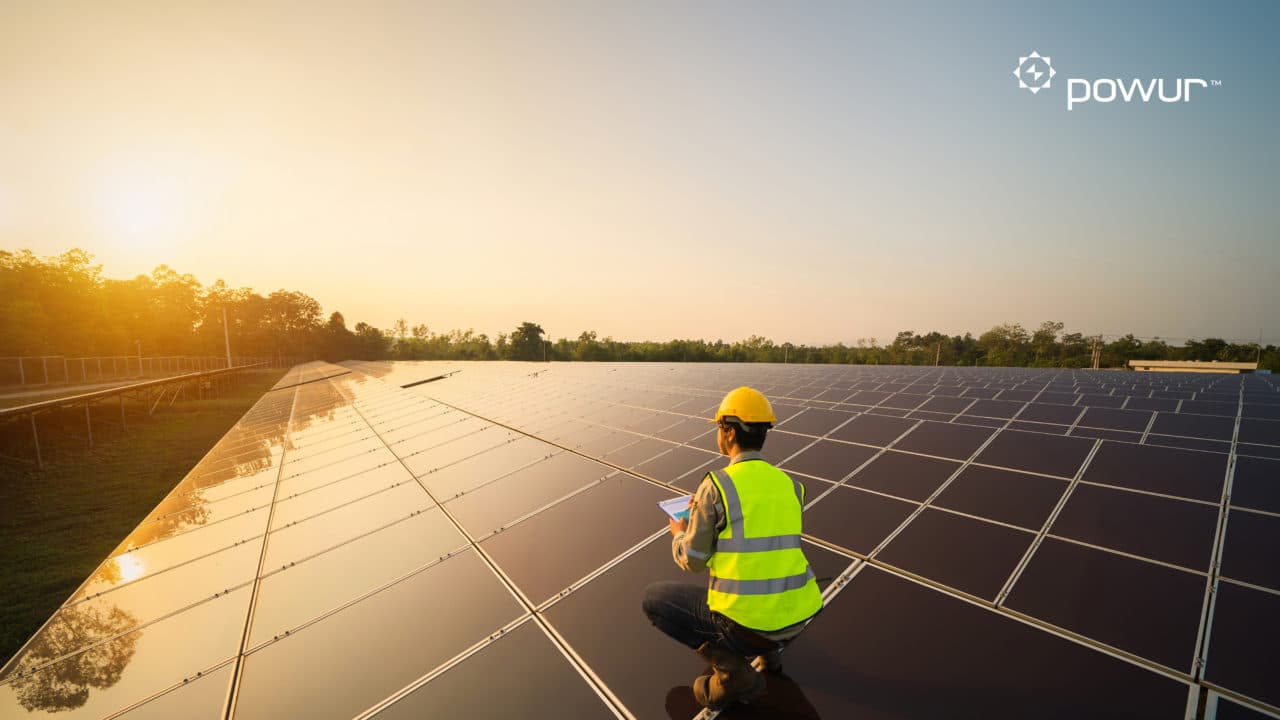Deforestation in the Amazon Rainforest
The deforestation of the Amazon Rainforest is amongst the world's worst environmental disasters.
Since the beginning of human history, people have cut down trees to make way for agricultural or commercial production, the construction of houses or to supply the required demands for timber.
Deforestation in Latin America results from problems associated with overpopulation, which has been occurring since the mid-twentieth century. The tropical rainforest is fading away quickly and is at risk of disappearing forever.
Since the onset of large-scale colonization and development initiatives in the 1960s, deforestation has posed a significant threat to the Amazon rainforest. Historically, the Amazon covered a substantial portion of South America's land area, but due to relentless deforestation, significant parts have been lost. This reduction is primarily driven by logging, agriculture, mining, and infrastructure development, leading to widespread loss of habitat, biodiversity, and vital ecosystem services. The ongoing deforestation not only threatens countless plant and animal species but also contributes to climate change by releasing significant amounts of stored carbon dioxide into the atmosphere. The urgent need to protect and restore the Amazon is paramount for maintaining global ecological balance and combating climate change.
Experts warn that the Amazon rainforest could face extensive deforestation within the next few decades if current trends continue. Additionally, they estimate that a significant proportion of the world's animal and plant species could become extinct or severely endangered within the next 25 years due to habitat destruction, climate change, and other human activities. The loss of such a substantial portion of the world's biodiversity would have devastating impacts on global ecosystems, disrupting ecological balance and diminishing the natural resources that humanity relies on for survival. Immediate and concerted efforts are necessary to reverse these trends and protect the planet's biodiversity.
Natural Health Benefits
The Amazonian rainforest is crucial to the health of our planet and its inhabitants. This vast and vibrant ecosystem is a storehouse of plant and animal species, representing a vital source of biodiversity. Remarkably, over a quarter of all pharmaceutical products are derived from rainforest plants, highlighting the immense medical potential of this region. The Amazon has provided treatments for diseases such as leukemia, Hodgkin's disease, and snake bites, as well as breast, cervical, and testicular cancers. Additionally, its unique flora is currently being researched for potential treatments for AIDS. The preservation of the Amazon is not only vital for maintaining biodiversity but also for sustaining the invaluable medical resources it offers to humanity.
Importance to the Biosphere
The Amazon rainforest plays a crucial role in maintaining the planet's health by regulating climate, providing hydrological services, sequestering carbon, protecting against fires, facilitating pollination, and mitigating disease. It is often referred to as the "lungs of the Earth" because it produces about 20% of the world's oxygen and absorbs vast amounts of carbon dioxide, helping to stabilize global climate patterns.
Covering approximately 40% of South America, the Amazon represents around 54% of the remaining rainforests on Earth, making it one of the most significant and vital ecosystems. It harbors an incredible diversity of life, with over half of all plant and animal species on the planet residing within its bounds. The rainforest is also home to numerous indigenous tribes, whose cultures and livelihoods are intricately tied to the health and preservation of this vast natural habitat. The Amazon's preservation is essential not only for biodiversity but also for the well-being of our global environment.
The Rainforest At Risk
Global warming is both a consequence and a driver of deforestation, creating a vicious cycle that exacerbates environmental degradation. Human activities, including industrial production and transportation, release greenhouse gases that contribute to global warming. This, in turn, affects the Amazon rainforest by altering its climate and increasing the frequency and severity of droughts, temperature changes, and forest fires.
As temperatures rise, prolonged droughts become more common, weakening trees and making them more susceptible to fires. These fires, whether naturally occurring or human-induced, lead to significant loss of forest cover. Additionally, the stress from higher temperatures and water scarcity hinders the rainforest's ability to regenerate and maintain its vital ecosystem functions. This cycle of warming and deforestation not only threatens the biodiversity of the Amazon but also diminishes its capacity to act as a carbon sink, further accelerating global climate change. Immediate action to reduce greenhouse gas emissions and protect the rainforest is essential to breaking this destructive feedback loop.
Temperature Changes
Latin America, like many regions around the world, is suffering from the profound effects of climate change. Increased concentrations of atmospheric carbon dioxide, primarily due to human activities such as industrial emissions and transportation, have led to a significant rise in global average surface temperatures.
The Amazon rainforest is experiencing drastic climate changes due to these elevated levels of carbon dioxide. Since the onset of the industrial revolution, atmospheric carbon dioxide concentrations have surged by over 40%, driven by pollution from automobiles, industries, and other human activities. This environmental shift poses severe challenges to the indigenous peoples whose livelihoods are intricately tied to the natural resources of the Amazon rainforest.
In the Andes, the impact of rising surface temperatures is starkly visible as glaciers rapidly melt. This glacial retreat threatens local water supplies and ecosystems. Additionally, large ice blocks breaking off from the Antarctic are contributing to rising sea levels, which, in turn, affect the water cycle of the Amazon River and its connection to the Atlantic Ocean. These interconnected changes highlight the urgent need for comprehensive climate action to protect both local communities and global ecosystems from the escalating effects of climate change.
More Frequent Floods
Every year, the water level of the Amazon River rises over thirty feet, leading to the flooding of nearby forests. Recently, these floods have become more extensive than usual, exacerbating deforestation in the region.
As global temperatures continue to increase due to atmospheric pollution, this trend is expected to worsen. The rise in temperatures intensifies the water cycle, leading to more severe and frequent flooding events in the Amazon rainforest. These floods not only cause immediate damage to the forest ecosystem but also contribute to long-term deforestation, undermining the resilience and biodiversity of this critical environment. Addressing pollution and mitigating climate change are essential to curbing these destructive flooding patterns and protecting the Amazon rainforest.
Droughts
Researchers believe that the increase in carbon dioxide concentrations is significantly impacting plant life in the Amazon rainforest. Since plants utilize carbon dioxide for photosynthesis, the elevated levels are effectively fertilizing the vegetation, leading to intensified competition for soil, light, and water.
Larger and faster-growing trees benefit disproportionately from this increased carbon dioxide, overshadowing smaller and younger trees. This competitive imbalance hinders the survival of smaller trees, contributing to deforestation as these younger plants struggle to thrive. Consequently, the forest is not regenerating as it naturally should, resulting in fewer new trees being established. If this trend continues, it may lead to a future where new generations of trees are unable to replace the old, threatening the sustainability and biodiversity of the Amazon rainforest.
Not Enough Water
The Amazon rainforest has a natural ability to absorb and store water during periods of heavy rain, releasing it gradually during the dry season to sustain the ecosystem. However, as the climate becomes increasingly dry, the trees struggle to retain sufficient water to survive.
Projections indicate that average global surface temperatures could rise by 2 to 8 degrees Celsius over the next century. Such a significant temperature increase would exacerbate drought conditions, potentially transforming vast areas of the rainforest into dry tropical grasslands and barren soils. This shift would drastically alter the region's biodiversity and disrupt the vital ecological functions the Amazon rainforest currently provides.
Forest Fires
The Amazon rainforest is particularly at risk of accidental forest fires during the dry season. Global warming has led to drier conditions, making plants more vulnerable to ignition.
During these dry periods, especially in El Niño years—a cyclical disruption of the ocean-atmosphere system—agricultural fields are more prone to catching fire, which can then spread into the nearby rainforest. In fact, most forest fires occur during El Niño years. The strong El Niño events of 1997 and 1998 contributed to massive forest fires, burning over 40,000 square kilometers of forest.
These fires not only devastate the forest and wildlife but also release significant amounts of carbon into the atmosphere, further contributing to global warming. This creates a vicious cycle where increased temperatures lead to more fires, which in turn release more carbon dioxide, exacerbating climate change. If these trends of rising temperatures, droughts, and forest fires continue, the Amazon rainforest could ultimately transform into a dry, barren landscape.
The red dots depict forest fires and a large cloud of smoke can be seen (bottom left)
Cattle Ranching
One of the key contributors to the deterioration of the Amazon rainforest is the extensive use of land for cattle ranching. Livestock occupies about 70% of the deforested areas, significantly impacting the forest's ecosystem (for more information, see the meat industry's effects on cattle ranching).
The cattle ranching system in the Amazon relies heavily on grazing, utilizing both cultivated and native pastures throughout the year. However, beef production in the tropical rainforest is notoriously inefficient. This inefficiency stems from the over-exploitation of grasslands, poor management practices, and the low fertility of the soil, which is characterized by low levels of phosphorus and high acidity.
Brazil is home to over 200 million heads of cattle, making it the world's second-largest herd, surpassed only by India. Over a third of Brazil's cattle are found in the central-west region, particularly in the state of Mato Grosso, which alone accounts for 13% of the country's herds.
Over the past fifteen years, cattle production has increased, with production areas shifting from the southeast to the northern regions of Brazil. This shift is largely due to the displacement of ranchers caused by the expansion of soy cultivation. Between 2001 and 2005, the cattle herd in northern Brazil increased by 37%, highlighting the ongoing pressure on the Amazon rainforest from agricultural activities.
Timber Extraction and Deforestation in the Amazon
Timber extraction is a major driver of deforestation in the Amazon rainforest and significantly contributes to Brazil's economic development. Despite improvements in logging techniques and increased awareness of the importance of preserving rainforests, illegal logging remains rampant. It is estimated that around 40% of the logging activities in the Amazon are illegal, particularly concentrated in states like Mato Grosso, Amazonas, and Rondônia.
The harvested timber in Brazil is predominantly used domestically, though exports have been increasing. In 1998, 14% of the timber was exported, rising to 36% by 2004. Currently, approximately 10,000 to 15,000 square kilometers of forest are exploited annually by logging activities. This unsustainable logging often leads to further deforestation as logged forests are frequently converted into agricultural and pasture lands.
Unregulated logging creates larger gaps in the forest canopy, making the Amazon more susceptible to natural fires. These fires, which often start in agricultural areas and pastures, can spread uncontrollably into the forest, exacerbating the damage caused by logging and further contributing to carbon emissions. This cycle of deforestation, degradation, and fire poses a severe threat to the Amazon rainforest, its biodiversity, and its role in regulating global climate.
Oil and Mining in the Amazon Rainforest
The Brazilian Amazon is rich in natural resources, attracting numerous prospectors seeking fortune through the extraction of minerals such as bauxite, diamonds, gold, iron, oil, and ore. This resource wealth makes the region a hotspot for mining activities, but it comes at a significant environmental cost.
Mining operations in the Amazon are closely linked to the degradation of ecosystems. The process often leads to soil erosion, runoff, infrastructure development, and environmental pollution. Historically, Brazil has a long history of gold mining, which has often involved hazardous working conditions. Between 1550 and 1880, gold mining released over 200,000 metric tonnes of mercury into the environment. This mercury does not degrade easily and poses long-term health risks to ecosystems and humans exposed to it.
Today, Latin America holds a substantial share of global mining profits, with Brazil, Chile, and Peru being the leading mining countries. Unfortunately, mining activities in forested areas contribute to significant deforestation and environmental damage. The chemicals used in mining operations often pollute nearby rivers and downstream farmlands, further exacerbating the ecological impact.
The challenge remains to balance the economic benefits of mining with the urgent need to protect the Amazon's fragile ecosystems and the health of its inhabitants. Sustainable mining practices and stricter regulations are essential to mitigate these adverse effects and preserve the Amazon for future generations.
Promoting Awareness - The Urgent Need to Protect the Amazon Rainforest
Deforestation in the Amazon rainforest is driven by a complex interplay of factors including global warming, colonization, and economic development. These forces have led to the exploitation of one of the world's most vital ecosystems, threatening its existence and the myriad of life it supports.
Human settlement and economic activities should not come at the expense of the environment. Rather than exploiting the land, there is an imperative need to conserve it. Unsustainable practices not only degrade the rainforest but also undermine its capacity to provide essential ecological services, such as carbon sequestration and biodiversity preservation.
If the current trends continue unchecked, the Amazon rainforest may one day be relegated to the pages of history books. It is our collective duty to raise awareness and educate others about the critical situation facing the Amazon. By fostering a deeper understanding of the issues and promoting sustainable practices, we can inspire meaningful action.
Addressing climate change is pivotal in the effort to save the Amazon. Implementing robust conservation strategies, enforcing stricter regulations on deforestation and mining, and supporting sustainable development initiatives are essential steps. Through concerted global efforts, we can preserve the Amazon rainforest for future generations, ensuring that it continues to thrive as a cornerstone of our planet's ecological health.
ChatGPT was used to help create this article
Further Reading and Sources
Join the Community and Newsletter (5000 Subscribers)
You can subscribe to my Substack Page or see the archives of previous posts. More great content coming soon!
Go Solar!
If you live in the United States and want to go solar, now is your chance! Visit Powur
Also, more importantly, you could become an ambassador for Powur and earn $1000 per successful referral. This is a fantastic opportunity to help the environment by helping your bottom line.
You even have the opportunity to become a solar professional, which takes it a step further. Do this if you want to really work in the solar industry. After going through a training, you can earn on average between $2000 to $4000 USD per panel installed. You don't have to be an American to be a solar professional for Powur, but it makes it a lot easier.
Recent Articles
-
Climate Change Quotes by Scientists Around the World
Aug 24, 24 02:01 PM
Explore impactful climate change quotes by scientists. Discover the wisdom and insights of experts advocating for a sustainable future. -
The Blueprint for a Smart and More Sustainable Home
Aug 21, 24 09:57 AM
These days, the concept of “home” has evolved to encompass more than just a physical space, reflecting one’s values, as well. As concerns over environmental -
Green Steps: Practical Measures for Overcoming Climate Change Anxiety
Aug 01, 24 12:46 PM
Climate anxiety affects many people today, and taking definitive action can soothe these concerns while positively impacting the world. By educating yourself -
8 Steps to Launching a Green Building Business
Jul 10, 24 09:13 PM
Have you been thinking about starting your own green building business? If so, you’ve come to the right place. In this blog post, we’ll go over everything
Powur - Solar Power at your Fingertips
Earn $1000 per referral by becoming an ambassador for Powur, a great solar power company in the United States.
If you become an ambassador for solar power, you have three incredible incentives:
- Help yourself by earning $1000 each time you successfully refer someone to solar
- Help create a better world for the next generation
- Help fund the Climate Change Guide, which will continue to spread awareness about climate change. We have been spreading awareness since 2011 to millions of people from nearly 200 countries.
Moreover, you can become a solar professional like me by joining Powur. Take your Powur back!
